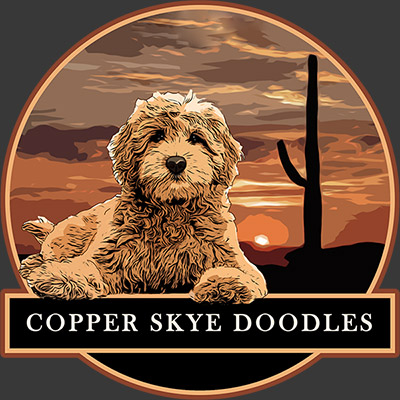Mini Goldendoodles
Mini Goldendoodles
Mini Goldendoodles are smaller dogs with big hearts and clever brains. They are loyal companions who enjoy staying active and spending time with people. Mini Goldendoodles are social by nature and very eager to please. They’re a great fit for first time dog owners because they are one of the easier dogs to train; they are smart and respond well to positive reinforcement.
Mini Goldendoodles are a cross between smaller sizes of a Golden Retriever and Poodle. The blend of personalities brings together the intelligence of a Poodle and the affectionate, gentleness of a Golden Retriever. Goldendoodles were originally bred to be guide dogs. Mini Goldendoodles are the perfect size to play well with children or provide comforting companionship to adults of all ages.
Mini Goldendoodles are smaller dogs with big hearts and clever brains. They are loyal companions who enjoy staying active and spending time with people. Mini Goldendoodles are social by nature and very eager to please. They’re a great fit for first time dog owners because they are one of the easier dogs to train; they are smart and respond well to positive reinforcement.
Mini Goldendoodles are a cross between smaller sizes of a Golden Retriever and Poodle. The blend of personalities brings together the intelligence of a Poodle and the affectionate, gentleness of a Golden Retriever. Goldendoodles were originally bred to be guide dogs. Mini Goldendoodles are the perfect size to play well with children or provide comforting companionship to adults of all ages.
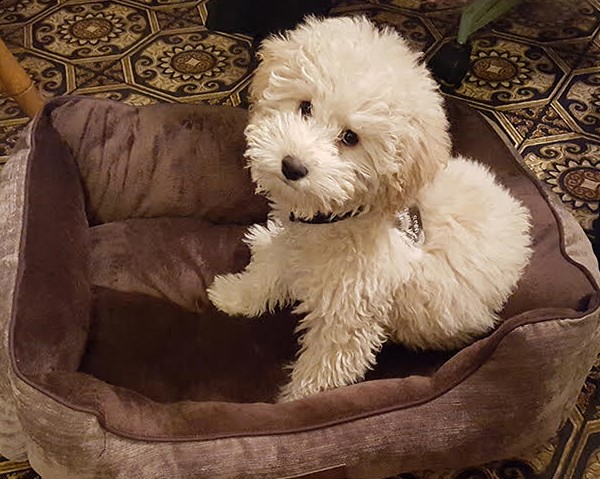
Sizes of Mini Goldendoodles
There are different sizes of mini Goldendoodles. The sizing of this breed is quite flexible which makes Goldendoodles a great fit for many families. The variety in size depends mostly on the genetic makeup of each parent. You can gauge a puppy’s estimated adult weight by gauging the parents’ sizes. If the parents are similar in weight, you can make a more reliable prediction about the future size of your puppy.
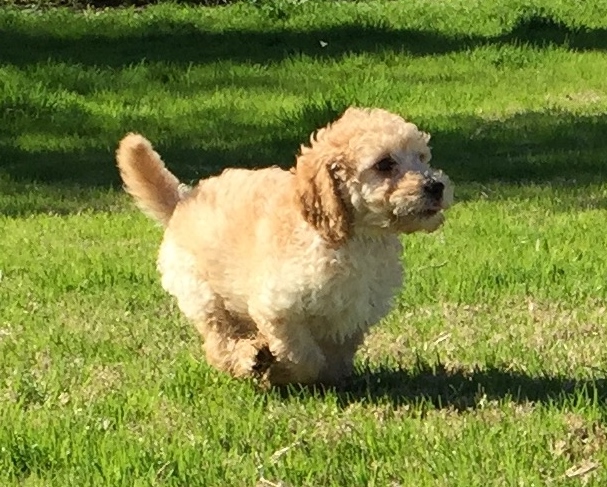
Mini Goldendoodles may be a great fit for you if you have downsized to a more compact space or if you enjoy walks with smaller dogs. Adults often prefer miniature size dogs not only because they will cuddle right in your lap, but also, they are low maintenance and more cost-effective. Mini Goldendoodles eat less, require slightly less exercise, produce less waste, and usually come with a lower grooming bill.
Smaller dogs are also a great fit for families with babies or toddlers, who may be concerned about large dogs knocking over or intimidating crawlers or young walkers. Mini Goldendoodles are easier to pick up, for bathtime or to when traveling on a plane. They are also easier for children to walk on a leash. However, mini Goldendoodles can tire out more easily and cannot always handle the same type of rough-housing that larger Goldendoodles enjoy and manage.
Sizes of Mini Goldendoodles
There are different sizes of mini Goldendoodles. The sizing of this breed is quite flexible which makes Goldendoodles a great fit for many families. The variety in size depends mostly on the genetic makeup of each parent. You can gauge a puppy’s estimated adult weight by gauging the parents’ sizes. If the parents are similar in weight, you can make a more reliable prediction about the future size of your puppy.
Mini Goldendoodles may be a 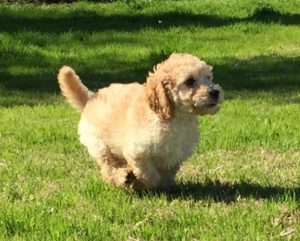

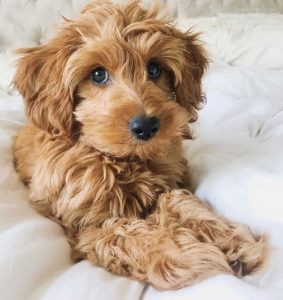 great fit for you if you have downsized to a more compact space or if you enjoy walks with smaller dogs. Adults often prefer miniature size dogs not only because they will cuddle right in your lap, but also, they are low maintenance and more cost-effective. Mini Goldendoodles eat less, require slightly less exercise, produce less waste, and usually come with a lower grooming bill.
great fit for you if you have downsized to a more compact space or if you enjoy walks with smaller dogs. Adults often prefer miniature size dogs not only because they will cuddle right in your lap, but also, they are low maintenance and more cost-effective. Mini Goldendoodles eat less, require slightly less exercise, produce less waste, and usually come with a lower grooming bill.
Smaller dogs are also a great fit for families with babies or toddlers, who may be concerned about large dogs knocking over or intimidating crawlers or young walkers. Mini Goldendoodles are easier to pick up, for bathtime or to when traveling on a plane. They are also easier for children to walk on a leash. However, mini Goldendoodles can tire out more easily and cannot always handle the same type of rough-housing that larger Goldendoodles enjoy and manage.
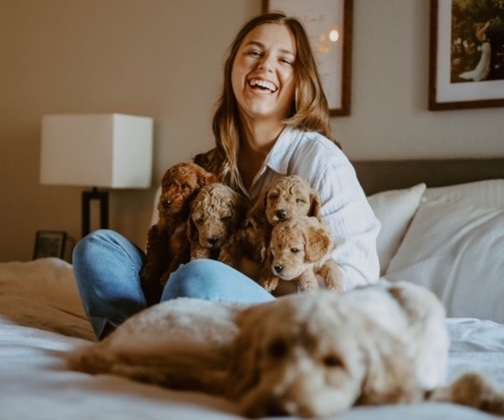
Mini Goldendoodle Breeding
There are a variety of options for breeding mini Goldendoodles. My top priority is to keep mom and puppies in the best health with loving care. With miniature sizing, I want to make sure the mom is a healthy size for carrying her puppies. Here are typical breeding matches:
- Smaller Golden Retriever mom and smaller or miniature Poodle dad
- Smaller Poodle mom and mini Goldendoodle dad
- Mini Goldendoodle mom and mini Goldendoodle dad
I do not take the risk of breeding a miniature Poodle mom with a smaller Golden Retriever dad. There are other options with fewer complications that provide a similar sized mini Goldendoodle. Most of my matches have a higher percentage of Poodle than Golden Retriever, to maintain less variability in the size and structure of my mini Goldendoodles. I am always looking out for my parents so that they continue to live healthy and happy lives.
Feel free to ask us about your puppy’s parentage to learn more about the specific characteristics of your mini Goldendoodle’s litter.


Mini Goldendoodle Breeding
There are a variety of options for breeding mini Goldendoodles. My top priority is to keep mom and puppies in the best health with loving care. With miniature sizing, I want to make sure the mom is a healthy size for carrying her puppies. Here are typical breeding matches:
- Smaller Golden Retriever mom and smaller or miniature Poodle dad
- Smaller Poodle mom and mini Goldendoodle dad
- Mini Goldendoodle mom and mini Goldendoodle dad
I do not take the risk of breeding a miniature Poodle mom with a smaller Golden Retriever dad. There are other options with fewer complications that provide a similar sized mini Goldendoodle. Most of my matches have a higher percentage of Poodle than Golden Retriever, to maintain less variability in the size and structure of my mini Goldendoodles. I am always looking out for my parents so that they continue to live healthy and happy lives.
Feel free to ask us about your puppy’s parentage to learn more about the specific characteristics of your mini Goldendoodle’s litter.

Mini Goldendoodles Personality and Temperament
When you combine two breeds known for cleverness, trainability, emotional sensitivity and friendliness with people, you can see why the personality of Goldendoodle is such a great fit for so many people. Minimal shedding is also great for individuals with allergies.
Mini Goldendoodles Personality and Temperament
When you combine two breeds known for cleverness, trainability, emotional sensitivity and friendliness with people, you can see why the personality of Goldendoodle is such a great fit for so many people. Minimal shedding is also great for individuals with allergies.
Mini Goldendoodles have these same traits, with some variation. Adding the miniature Poodle for a smaller dog can add some extra spunkiness to your companion. Some mini Goldendoodles tend to be more excitable. In the most challenging scenarios, your puppy may need extra training for nippiness. However, the majority of mini Goldendoodles are eager to please, people oriented, and loyal companions. They also love to stay by your side and snuggle in your lap for some extra quality time together.




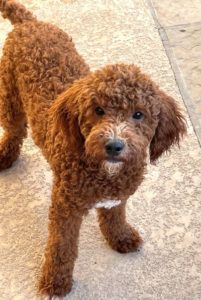

Mini Goldendoodles have these same traits, with some variation. Adding the miniature Poodle for a smaller dog can add some extra spunkiness to your companion. Some mini Goldendoodles tend to be more excitable. In the most challenging scenarios, your puppy may need extra training for nippiness. However, the majority of mini Goldendoodles are eager to please, people oriented, and loyal companions. They also love to stay by your side and snuggle in your lap for some extra quality time together.
Mini Goldendoodle Lifespan and Care
You may wonder about the average lifespan of mini Goldendoodles. Typically, Poodles have a longer lifespan of 10-18 years, while Golden Retrievers live for 10-12 years. Smaller dogs tend to live longer than larger dogs, but much of this depends on genetics. You can expect on average a mini Goldendoodle will live for 12-15 years. An F1b Goldendoodle has a higher percentage of Poodle in the genetic makeup and raises the likelihood that your mini Goldendoodle will live longer.
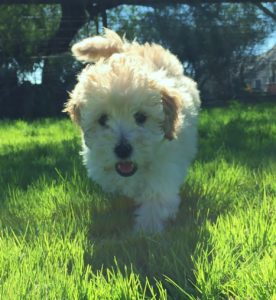
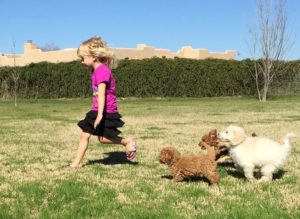
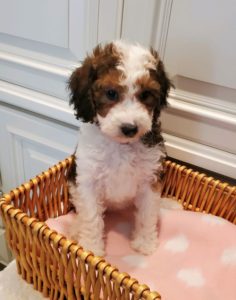
There are four main factors to keep in balance to keep your mini Goldendoodle healthy and happy:
- Nutrition
- Exercise
- Teeth
- Grooming
Nutrition
While mini Goldendoodles eat less in quantity, the quality of their nutrition matters. An appropriate diet begins as a puppy and continues throughout their life. It is important to feed your pup a balanced diet, making sure they get all of the vitamins and minerals necessary for good health.
Make sure quality, nutritional treats are no more than 10% of your Goldendoodle’s diet. Gaining excess weight has many negative health impacts for dogs. Usually, the overuse of high calorie treats is a big contributor to weight gain in pups. When you begin training, consider using treats that are meat based and low calorie. Or, certain vegetables and fruits like carrots and apples may be good healthy alternatives.
Exercise

Mini Goldendoodles tend to need slightly less exercise than standard Goldendoodles, but they still support an active lifestyle. They enjoy walks, play, and lots of time with you. Mini Goldendoodles can play in a smaller area in short bursts. These dogs are energetic but may lose stamina for longer exercise outings. They may require more short walks or attention throughout the day to stay mentally stimulated and healthy. Mini Goldendoodles are social and want to spend time with you.
Teeth
Keeping Goldendoodle teeth healthy requires regular attention. Frequently teeth are one of the most neglected parts of dog care, yet it’s one of the easiest areas to remedy. Maintaining a routine of teeth brushing with your mini Goldendoodle will assure they can happily eat and play without infections. Prevention also saves money in the long run, avoiding expensive tooth extractions. Both you and your pup will be happier with healthy teeth.
Mini Goldendoodle Lifespan and Care
You may wonder about the average lifespan of mini Goldendoodles. Typically, Poodles have a longer lifespan of 10-18 years, while Golden Retrievers live for 10-12 years. Smaller dogs tend to live longer than larger dogs, but much of this depends on genetics. You can expect on average a mini Goldendoodle will live for 12-15 years. An F1b Goldendoodle has a higher percentage of Poodle in the genetic makeup and raises the likelihood that your mini Goldendoodle will live longer.
There are four main factors to keep in balance to keep your mini Goldendoodle healthy and happy:
- Nutrition
- Exercise
- Teeth
- Grooming
Nutrition
While mini Goldendoodles eat less in quantity, the quality of their nutrition matters. An appropriate diet begins as a puppy and continues throughout their life. It is important to feed your pup a balanced diet, making sure they get all of the vitamins and minerals necessary for good health.
Make sure quality, nutritional treats are no more than 10% of your Goldendoodle’s diet. Gaining excess weight has many negative health impacts for dogs. Usually, the overuse of high calorie treats is a big contributor to weight gain in pups. When you begin training, consider using treats that are meat based and low calorie. Or, certain vegetables and fruits like carrots and apples may be good healthy alternatives.

Exercise
Mini Goldendoodles tend to need slightly less exercise than standard Goldendoodles, but they still support an active lifestyle. They enjoy walks, play, and lots of time with you. Mini Goldendoodles can play in a smaller area in short bursts. These dogs are energetic but may lose stamina for longer exercise outings. They may require more short walks or attention throughout the day to stay mentally stimulated and healthy. Mini Goldendoodles are social and want to spend time with you.
Teeth
Keeping Goldendoodle teeth healthy requires regular attention. Frequently teeth are one of the most neglected parts of dog care, yet it’s one of the easiest areas to remedy. Maintaining a routine of teeth brushing with your mini Goldendoodle will assure they can happily eat and play without infections. Prevention also saves money in the long run, avoiding expensive tooth extractions. Both you and your pup will be happier with healthy teeth.
Mini Goldendoodles and Grooming
Mini Goldendoodles with a higher percentage of Poodle genetics have the lowest shedding coats. Many people with allergies react more to dander than to fur. Goldendoodles tend to have low dander and minimal shedding. Coats of Goldendoodles vary widely in color and curl.
Goldendoodle puppies range from having curly fur, a shaggy coat, to loose or wavy hair. It’s helpful to know that the more curly the coat, the less shedding, due to the Poodle influence. However, curly coats are more likely to have knots or mats and require more frequent brushing at home, as well as higher maintenance grooming.
Wavy coats still require regular grooming, but tend to get tangled less. A wavy coat may only require brushing a few times a week. Typically, Goldendoodles only shed about as much as people, and there will be hair in the dog brush. Thankfully, the shedding on your floors and furniture is minimal.
Make sure you set aside time and a budget to keep your mini Goldendoodle’s coat in great shape. I recommend that you plan to have your pup groomed every 6-8 weeks. Frequently, groomers will offer reduced pricing for the smaller coat of your mini Goldendoodle.
Mini Goldendoodles and Grooming
Mini Goldendoodles with a higher percentage of Poodle genetics have the lowest shedding coats. Many people with allergies react more to dander than to fur. Goldendoodles tend to have low dander and minimal shedding. Coats of Goldendoodles vary widely in color and curl.
Goldendoodle puppies range from having curly fur, a shaggy coat, to loose or wavy hair. It’s helpful to know that the more curly the coat, the less shedding, due to the Poodle influence. However, curly coats are more likely to have knots or mats and require more frequent brushing at home, as well as higher maintenance grooming.
Wavy coats still require regular grooming, but tend to get tangled less. A wavy coat may only require brushing a few times a week. Typically, Goldendoodles only shed about as much as people, and there will be hair in the dog brush. Thankfully, the shedding on your floors and furniture is minimal.
Make sure you set aside time and a budget to keep your mini Goldendoodle’s coat in great shape. I recommend that you plan to have your pup groomed every 6-8 weeks. Frequently, groomers will offer reduced pricing for the smaller coat of your mini Goldendoodle.

Mini Goldendoodles For Adoption
Mini Goldendoodles For Adoption

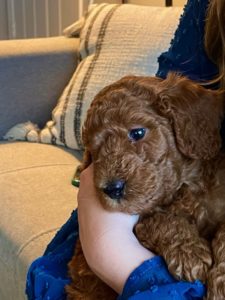

At Copper Skye Doodles, I want to share the joy a Goldendoodle can bring you and your family. Mini goldendoodles are intelligent and adoring, some of the most loving dogs you’ll ever meet. Their active lifestyle and trainability make them great companions and family dogs.
I have more than 20 years of experience breeding and loving Goldendoodles and I’d be happy to meet with you in person or over the phone to discuss your hopes and questions. Copper Skye Doodles has an outstanding reputation and has placed hundreds of mini Goldendoodles into loving homes. I’m happy to take the time to share more with you and learn about which Goldendoodle would fill your heart and home with affection and companionship.
Frequently Asked Questions
Goldendoodles are an intelligent and obedient family companion. They are everybody’s friend and devoted to their family. They are friendly towards children, other dogs and pets, and easy with strangers. They are social dogs, happiest when with people. Goldendoodles are likely to get into mischief and develop behavior problems if they spend most of their lives alone. Their intelligence, eagerness to please, and love of learning make them very easy to train.
Yes. As a hybrid cross, Goldendoodles will inherit fur that looks retriever-like, or poodle-like, but usually something in-between. Unclipped Goldendoodles will have hair about 4-7 inches long, shorter on the face and longer on the body, tail and legs. Without grooming, painful mats can form and your adorable pup will look neglected and unkempt. Expect to thoroughly comb or brush your Goldendoodle regularly (all the way down to the skin). A curly coat will require more brushing than a straight or wavy one. Head to a professional groomer every six to eight weeks or so.
Goldendoodles are energetic, active dogs. Of course, some will be more active than others, but like all dogs, if not given moderate amount of exercise each day, they can easily get into trouble. Plan on your Goldendoodle needing at least two 30-minute periods of exercise per day. This can be accomplished through various means, such as brisk walks, jogging, hiking, swimming, agility work, or just good old-fashioned backyard playtime. Although exercise is needed, they can easily adapt to a life in the city or on a farm or anything in between.
With a name like Goldendoodle, one might think that gold is the only color they come in, but nothing could be further from the truth! Goldendoodles come in a variety of colors, including black, chocolate, red, white, apricot, cream and brown. In addition to the wide variety of colors, Goldendoodles can also be found in a variety of patterns, including merle, brindle, phantom, sable, and parti. With the Poodle heritage and the Golden Retriever heritage both in play here, it’s not surprising that Goldendoodles come in so many colors and patterns. The Poodle and Golden Retriever ancestry both bring apricot, red, and cream to the mix. The same gene controls all three of these colors, but the intensity of the inherited gene is what determines the shade of the color.
Poodles also bring dark brown (chocolate), black, gray, and silver, as well as the patterns, to the mix.
The summary of colors from both Poodle and Golden Retriever is:
- Apricot – From both Poodle and Golden Retriever
- Red – From both Poodle and Golden Retriever
- Cream – From both Poodle and Golden Retriever
- Dark Brown (Chocolate) – Poodle Side
- Black – Poodle Side
- Gray – Poodle Side
- Silver – Poodle Side
- Blue – Poodle Side … Blue, in this case, is like a faded blackish gray
- White – Poodle Side
The summary of patterns inherited from the Poodle is:
- Solid Goldendoodle – This is one solid color.
- Parti Goldendoodle– This combination is white on at least 50% of the body with solid patches of any other color. This unique color may be red parti, chocolate parti, black parti, cream parti, merle parti, apricot parti, or phantom parti. The choices are almost endless.
- Merle Goldendoodle – This beautiful color is a combination of various colors. Because the merle gene can cause deafness or blindness, it’s a rare color.
- Phantom Goldendoodle – Super hard to find phantom Goldendoodles comprise two colors – a base shade (solid chocolate or solid black) and a lighter one. The lighter points are usually to be found above the eyes (eyebrows), on the side of the chest, muzzle, inside the legs and under the tail. Most phantom Goldendoodles are commonly black and tan, but this can vary, e.g., brown and silver. Phantom is a recessive gene, so both parents would need to have it for the puppy to inherit this pattern (so it’s not found in the first generation). However, it’s easy to tell a phantom dog right off as puppies are born with these specific markings. They don’t develop over time like other patterns.
- Sable Goldendoodle – Sable is a gene that gives the dog’s coat the appearance of two tones or colors, with the tips of the hair being black. While these dogs look either brown or black at birth, even at this early time, the root of the hair is much lighter than the tip. Sable Goldendoodles tend to hold onto their dark color around the face and ears. The rest of their coat settles into more of a cream or tan shade, although always with darker tips and lighter roots. This makes for a unique-looking dog!
- Abstract Goldendoodles – Dogs with abstract coats are mostly one single color (be it any of the ones outlined above) with touches of white. These are usually found on their face and around their chest and paws. Such dogs are also referred to as mismarked.
- Tuxedo Goldendoodles – Tuxedo Goldendoodles are another two-color mix. Any of the above colors are combined with white. However, the white is concentrated around the chest and front legs. This gives the pup the appearance of wearing a tuxedo (hence the name). As you can imagine, these dogs are popular because of their distinctive appearance – especially when in black and white. Their markings are apparent from birth. Although, naturally, the white splotches often begin small and get more prominent as the dog matures.
- Brindle Goldendoodles – Brindle, another parti-color pattern, is rarely seen but looks truly striking when coupled with the doodle’s attractive features. This unique pattern of dark and light coat is arranged in such a way as to make the dog look like it has tiger stripes. While the width and color of these stripes vary from dog to dog, in Goldendoodles, it usually takes the form of a black or brown base coat with lighter colored stripes.
- Tri-Colored Goldendoodles – With the increasing amount of multigenerational Goldendoodles, color options are becoming ever more varied. Tri-colored isn’t common to these dogs because this kind of coloring doesn’t occur in either Poodles or Golden Retrievers. However, it is very usual in other types like Bernedoodles (from the Bernese Mountain Dog). Often you will find that Goldendoodles that carry this coloring aren’t Goldendoodles, strictly speaking. They usually have a little of another breed in them – one that does carry the tri-color gene. Golden Mountain Doodles (Golden Retrievers, Bernese Mountain Dogs, and Poodles) are becoming increasingly popular, not least for their cool coloring.
In all honesty, with no coat color or pattern being better than any other in terms of health and behavior, your choice of Goldendoodle should be based on temperament over looks. However, everyone has different preferences about these things. So, once you have ascertained that the puppies you are checking out are all good, you can choose the one that looks best to you. Keep in mind that the Poodle fading and silvering genes make it quite likely that your dood’s coat color will change as they get older. Usually, the intensity is reduced, and black dogs switch to gray or silver while red ones dull down to apricot or cream.
There is no right or wrong answer to this question. Over the years I have discovered that there is very little difference between genders in terms of personality. By today’s standards most dogs are either spayed or neutered which levels the field by eliminating all hormones. I have males and females that are both sweet, smart, friendly, playful, loyal, gentle, etc. I also have some males and females that are highly energetic, mischievous, barkers, toy destroyers, etc. Bottom line, each and every dog/puppy has its own unique personality that’s his/hers alone, and that’s why we love them! However, I always tell prospective buyers that if they have a definite gender in mind then that’s the one they should go with.
Frequently Asked Questions
Goldendoodles are an intelligent and obedient family companion. They are everybody’s friend and devoted to their family. They are friendly towards children, other dogs and pets, and easy with strangers. They are social dogs, happiest when with people. Goldendoodles are likely to get into mischief and develop behavior problems if they spend most of their lives alone. Their intelligence, eagerness to please, and love of learning make them very easy to train.
Yes. As a hybrid cross, Goldendoodles will inherit fur that looks retriever-like, or poodle-like, but usually something in-between. Unclipped Goldendoodles will have hair about 4-7 inches long, shorter on the face and longer on the body, tail and legs. Without grooming, painful mats can form and your adorable pup will look neglected and unkempt. Expect to thoroughly comb or brush your Goldendoodle regularly (all the way down to the skin). A curly coat will require more brushing than a straight or wavy one. Head to a professional groomer every six to eight weeks or so.
Goldendoodles are energetic, active dogs. Of course, some will be more active than others, but like all dogs, if not given moderate amount of exercise each day, they can easily get into trouble. Plan on your Goldendoodle needing at least two 30-minute periods of exercise per day. This can be accomplished through various means, such as brisk walks, jogging, hiking, swimming, agility work, or just good old-fashioned backyard playtime. Although exercise is needed, they can easily adapt to a life in the city or on a farm or anything in between.
With a name like Goldendoodle, one might think that gold is the only color they come in, but nothing could be further from the truth! Goldendoodles come in a variety of colors, including black, chocolate, red, white, apricot, cream and brown. In addition to the wide variety of colors, Goldendoodles can also be found in a variety of patterns, including merle, brindle, phantom, sable, and parti. With the Poodle heritage and the Golden Retriever heritage both in play here, it’s not surprising that Goldendoodles come in so many colors and patterns. The Poodle and Golden Retriever ancestry both bring apricot, red, and cream to the mix. The same gene controls all three of these colors, but the intensity of the inherited gene is what determines the shade of the color.
Poodles also bring dark brown (chocolate), black, gray, and silver, as well as the patterns, to the mix.
The summary of colors from both Poodle and Golden Retriever is:
- Apricot – From both Poodle and Golden Retriever
- Red – From both Poodle and Golden Retriever
- Cream – From both Poodle and Golden Retriever
- Dark Brown (Chocolate) – Poodle Side
- Black – Poodle Side
- Gray – Poodle Side
- Silver – Poodle Side
- Blue – Poodle Side … Blue, in this case, is like a faded blackish gray
- White – Poodle Side
The summary of patterns inherited from the Poodle is:
- Solid Goldendoodle – This is one solid color.
- Parti Goldendoodle– This combination is white on at least 50% of the body with solid patches of any other color. This unique color may be red parti, chocolate parti, black parti, cream parti, merle parti, apricot parti, or phantom parti. The choices are almost endless.
- Merle Goldendoodle – This beautiful color is a combination of various colors. Because the merle gene can cause deafness or blindness, it’s a rare color.
- Phantom Goldendoodle – Super hard to find phantom Goldendoodles comprise two colors – a base shade (solid chocolate or solid black) and a lighter one. The lighter points are usually to be found above the eyes (eyebrows), on the side of the chest, muzzle, inside the legs and under the tail. Most phantom Goldendoodles are commonly black and tan, but this can vary, e.g., brown and silver. Phantom is a recessive gene, so both parents would need to have it for the puppy to inherit this pattern (so it’s not found in the first generation). However, it’s easy to tell a phantom dog right off as puppies are born with these specific markings. They don’t develop over time like other patterns.
- Sable Goldendoodle – Sable is a gene that gives the dog’s coat the appearance of two tones or colors, with the tips of the hair being black. While these dogs look either brown or black at birth, even at this early time, the root of the hair is much lighter than the tip. Sable Goldendoodles tend to hold onto their dark color around the face and ears. The rest of their coat settles into more of a cream or tan shade, although always with darker tips and lighter roots. This makes for a unique-looking dog!
- Abstract Goldendoodles – Dogs with abstract coats are mostly one single color (be it any of the ones outlined above) with touches of white. These are usually found on their face and around their chest and paws. Such dogs are also referred to as mismarked.
- Tuxedo Goldendoodles – Tuxedo Goldendoodles are another two-color mix. Any of the above colors are combined with white. However, the white is concentrated around the chest and front legs. This gives the pup the appearance of wearing a tuxedo (hence the name). As you can imagine, these dogs are popular because of their distinctive appearance – especially when in black and white. Their markings are apparent from birth. Although, naturally, the white splotches often begin small and get more prominent as the dog matures.
- Brindle Goldendoodles – Brindle, another parti-color pattern, is rarely seen but looks truly striking when coupled with the doodle’s attractive features. This unique pattern of dark and light coat is arranged in such a way as to make the dog look like it has tiger stripes. While the width and color of these stripes vary from dog to dog, in Goldendoodles, it usually takes the form of a black or brown base coat with lighter colored stripes.
- Tri-Colored Goldendoodles – With the increasing amount of multigenerational Goldendoodles, color options are becoming ever more varied. Tri-colored isn’t common to these dogs because this kind of coloring doesn’t occur in either Poodles or Golden Retrievers. However, it is very usual in other types like Bernedoodles (from the Bernese Mountain Dog). Often you will find that Goldendoodles that carry this coloring aren’t Goldendoodles, strictly speaking. They usually have a little of another breed in them – one that does carry the tri-color gene. Golden Mountain Doodles (Golden Retrievers, Bernese Mountain Dogs, and Poodles) are becoming increasingly popular, not least for their cool coloring.
In all honesty, with no coat color or pattern being better than any other in terms of health and behavior, your choice of Goldendoodle should be based on temperament over looks. However, everyone has different preferences about these things. So, once you have ascertained that the puppies you are checking out are all good, you can choose the one that looks best to you. Keep in mind that the Poodle fading and silvering genes make it quite likely that your dood’s coat color will change as they get older. Usually, the intensity is reduced, and black dogs switch to gray or silver while red ones dull down to apricot or cream.
There is no right or wrong answer to this question. Over the years I have discovered that there is very little difference between genders in terms of personality. By today’s standards most dogs are either spayed or neutered which levels the field by eliminating all hormones. I have males and females that are both sweet, smart, friendly, playful, loyal, gentle, etc. I also have some males and females that are highly energetic, mischievous, barkers, toy destroyers, etc. Bottom line, each and every dog/puppy has its own unique personality that’s his/hers alone, and that’s why we love them! However, I always tell prospective buyers that if they have a definite gender in mind then that’s the one they should go with.



